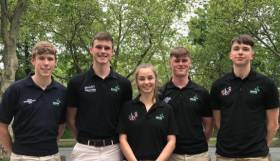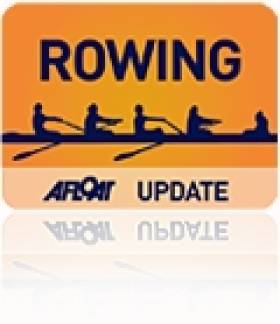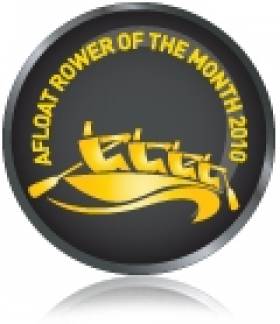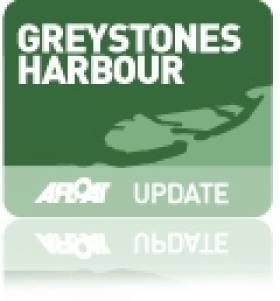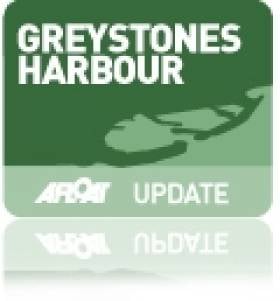Displaying items by tag: Rowers
Irish Atlantic Rowers Rescued After Storm Damage to Rudder
Donegal mountaineer Jason Black and rowing partner Neil Glover have been rescued by a merchant shipping vessel at the request of the Tenerife Coast Guard after storm conditions damaged their vessel during an Atlantic row.
The organisers of the C-Map Atlantic Dash, a 5,000-kilometre row from Lanzarote to Antigua, said that both men had been “transferred safely onto the merchant shipping vessel “Lagoa” as organised by the Tenerife coast guard”.
“They are safe and well and currently on their way to Lisbon in Portugal, which is the ship’s destination,” the organisers said.
“The storm came up over the top of us and turned us sideways, and as we surfed down the wave it snapped off the rudder,” Black said in a video posted to social media on Saturday.
 The merchant shipping vessel “Lagoa” has picked up transatlantic rowers Jason Black and Neil Glover
The merchant shipping vessel “Lagoa” has picked up transatlantic rowers Jason Black and Neil Glover
“Unfortunately, that left us rudderless, and we had no control of the boat. At that stage myself and Neil lowered the sea anchor,”he said.
“We have reached out to the Coastguard and they are liaising on a rescue with an American freight ship, it will be six hours away,”he had said.
Black explained that both men were safe, the boat was otherwise intact and stable and they had food and water.
Their rowing craft, Destiny’s Tide, was one of three boats participating in the Atlantic Dash, described as a “regatta” and not a race and one of the world’s toughest endurance events.
They were just over two weeks into their row and making good progress, lying in third position.
On Thursday, Black had anticipated a weather system which would require them to deploy their para-anchor, helping to stabilise their position during heavy winds.
The organisers were able to report last night that their boat was also taken on board the merchant ship.
“Often in recovery situations the boat is abandoned and cast adrift, but in a very fortunate turn of events, “Lagoa” is also attempting to tow Destiny’s Tide’s boat into Lisbon,”the Atlantic Dash organisers said.
“The YB tracker is still sending a signal as normal so you may see a large jump and change of direction as they make their way to Portugal,”they said.
“Whilst this is good news for the boat, there is still a chance she may need to be cast adrift (Neil and Jason will remain safe on Lagoa),”the organisers added.
Black and Glover had set out on the 5,000 kilometre row to raise funds for the charity Race Against Dementia, initiated by racing driver Jackie Stewart.
Black, from Letterkenny, Co Donegal, climbed Mount Everest in May 2013, and the world’s second highest peak, K2, in 2018, and runs his own professional expedition company.
Newcastle RNLI Lifeboat Rescue Five GB Row Challenge Rowers in Difficulty off Ardglass
Newcastle RNLI rescued five rowers early yesterday morning (Sunday 26 June) after they got into difficulty in challenging weather conditions 23 nautical miles northeast of Ardglass.
The crew from the GB Row Challenge had left Tower Bridge London on 12 June to circumnavigate Great Britain and to collect environmental data.
The vessel had been monitored throughout the night by HM Coastguard with frequent radio transmissions. During a check at 7 am on Sunday, the rowers explained they had capsized and righted themselves but were unable to row.
Newcastle RNLI was requested to launch their all-weather lifeboat at 7.15 am. Weather conditions at the time were poor with a Force 7 southerly wind and very rough seas. The lifeboat launched under Gerry McConkey and with crew members Shane Rice, Lochlainn Leneghan, Declan McClelland, Karl Brannigan and Declan Barry onboard. Conditions deteriorated following the launch with weather increasing to a Force 9 southerly wind and high seas.
On arrival at 9.24 am, the volunteer crew assessed the situation and decided a tow was necessary to bring the vessel’s crew to safety. Such were the conditions at sea that it took three attempts before a tow was successfully established. Newcastle RNLI then towed the vessel to the nearest safe port at Ardglass, a passage that took two hours.
The rowers were met by Newcastle Coastguard, and one was checked over by the Northern Ireland Ambulance Service.
Speaking following the call out, Newcastle RNLI Coxswain Gerry McConkey said: “We would like to wish the rowers well following their experience yesterday after they got caught by the poor weather. I would also like to commend our volunteer crew who used their skills and training to work in what were extremely challenging conditions that deteriorated during the call out to successfully bring the five people to safety.”
As previously reported on Afloat.ie, another crew of round-Britain rowers were rescued by Red Bay RNLI on Saturday (25 June) amid “hugely challenging conditions” at sea off Northern Ireland.
Greenblades Allows Public to Support Up-and-Coming Rowers
#Rowing: Rowing Ireland has launched Greenblades, an initiative to help fund the junior, under 23 and development teams by means of donations. Currently, development rowers often call heavily on support from their families, as well as Rowing Ireland and whatever other funding they can muster.
It takes a lot to be an international rower and stars like Sanita Puspure, Paul O’Donovan and Gary O’Donovan have been supported in their development before they reached the top level in the world.
Rowing Ireland says that Greenblades will ensure that athletes who are representing Ireland will be supported to reach their full potential so that they can compete at the highest level possible.
Rowing Ireland’s chief executive, Michelle Carpenter said: “It is key that we do everything to support our up-and-coming athletes as we prepare to successfully support their future careers by giving them the opportunity to row in Paris [the 2024 Olympic Games] and beyond.
She said that the athletes are the future of Irish rowing. Consideraton must be give to the next two years, but also the next four and eight years.
“Rowing should be accessible to everyone who wants to compete, be it at domestic or high-performance level,” Carpenter added.
Rowing Ireland says that all donations will go directly to the athletes who will be competing at the World Under-23 Championships in Florida and the World Junior Championships in Tokyo.
Donations can be made at greenblades.ie
Ireland Rowers Miss Chance to Qualify Olympic Boat
Only the top two boats (places seven and eight overall) were guaranteed a place at London 2012. Germany won the race by leading virtually all the way and China took the second qualification spot by taking out the United States in the second 1,000 metres. Ireland were in touch at 500 metres but could not keep contact with the head of the field.
In the most dramatic race of the day, Germany lost the men's quadruple sculls gold to Australia virtually on the line when Lauritz Schoof missed a stroke as the Germans were leading. Britain won their first gold in an Olympic event through Anna Watkins and Katherine Grainger in the women's double, but New Zealand took the men's pair, leaving Britain in second, and the men's single scull, where Mahe Drysdale regained his crown. Coleraine's Alan Campbell took bronze.
World Rowing Championships, Bled, Slovenia – Day Seven (Selected Results)
Men
Pair – A Final: 1 New Zealand 6:14.77, 2 Britain 6:16.27, 3 Italy 6:21.33.
Quadruple Sculls – A Final: 1 Australia 5:39.31, 2 Germany 5:39.56, 3 Croatia 5:42.82.
Single Sculls – A Final: 1 New Zealand (M Drysdale) 6:39.56, 2 Czech Republic (O Synek) 6:40.05, 3 Britain (A Campbell) 6:44.86.
Women
Four – A Final: 1 United States 6:30.30, 2 Australia 6:31.18, 3 Netherlands 6:34.06.
Lightweight Quadruple Scull – A Final: 1 Britain 6:28.14, 2 China 6:30.41, 3 United States 6:33.91.
Double Scull – A Final: 1 Britain 6:44.73, 2 Australia 6:45.98, 3 New Zealand 6:46.74. B Final (Places 7 to 12; first two boats qualify for Olympic Games 2012): 1 Germany 6:57.43, 2 China 6:58.41, 3 United States 6:59.83, 4 Finland 7:04.51, 5 Serbia 7:05.75, 6 Ireland (L Dilleen, S Puspure) 7:13.92.
Adaptive
Legs, Trunk and Arms Mixed coxed Four – A/B Semi-Final (First Three to A/B Semi-Final; rest to B Final): 1 Germany 3:30.78, 2 Ireland (A-M McDaid, S Caffrey, S Ryan, K du Toit; cox: H Arbuthnot) 3:32.63, 3 United States 3:32.98; 4 China 3:35.66, 5 Italy 3:41.51, 6 Russia 3:45.79.
Dilleen and Puspure Award-Winning Double Rowers
The Ireland women’s double scull of Lisa Dilleen and Sanita Puspure are the Afloat Rowers of the Month for May. Despite being a new crew, formed in the weeks running up to the regatta, Dilleen and Puspure performed remarkably well at the World Cup in Munich. They finished second in their semi-final on Saturday and fifth in Sunday’s A Final. They are deserving winners of the Afloat Rowers of the Month award.
Rower of the Month awards: The judging panel is made up of Liam Gorman, rowing correspondent of The Irish Times, President of Rowing Ireland Anthony Dooley and David O'Brien, Editor of Afloat magazine. Monthly awards for achievements during the year will appear on afloat.ie and the overall national award will be presented to the person or crew who, in the judges' opinion, achieved the most notable results in, or made the most significant contribution to rowing during 2011. Keep a monthly eye on progress and watch our 2011 champions list grow.
Greystones Harbour Open Day Gives Chance to See Impressive Marine Works
This is a chance, says local councillor Derek Mitchell, to see what has been achieved behind the hoardings in the last two years. "All marine works will be finished in 2010 and it is impressive to see what has been achieved. Currently much of the earth stored on top of D'Arcys field is being moved to beside the new harbour and it is quite mucky which limits the area which the public can access. However it will be a good chance to see behind the hoardings" Mitchell told Afloat.ie.
The next stage will start in January and finish in December 2011 after which most hoardings will come down. This stage consists of the 4 storey Health Centre, public square and free clubhouses for the Sea Scouts, Rowers, Divers, Sailors and Anglers.
Greystones Harbour Facilities to be Complete by End 2011
Tuesday nights Greystones Town Council meeting was informed by Greystones harbour developer Sispar that the major work on the seawalls would be complete at the end of November 2010.
Following this, construction of the Health Centre, public square and Community buildings for the Sea Scouts, Rowers, Anglers, Divers and Sailors will start in January and should be complete in December 2011.
The hoardings which have blocked the view of the harbour and proposed marina will be taken down as these works are completed in 2011.
Local councillor Derek Mitchell (and a Ruffian keelboat champion) told Afloat.ie: "I welcome this as Greystones had been trying to get the harbour rebuilt for over a hundred years and this will create the best Community Harbour in Ireland".
Councillor Mitchell adds "The developer has applied to change some of the housing and add 34 houses to the North. Wicklow County Council is to vote on this in December. These houses may not be built yet, depending on the housing market, but access will be provided across the site to the North Beach and the new swimming beach there"
"The meeting was also told that the loan would be going in to NAMA, as all loans will, however this is not expected to make any difference to the project", he added.
Councillors asked for more Community tours so that people could see what has been achieved.



























